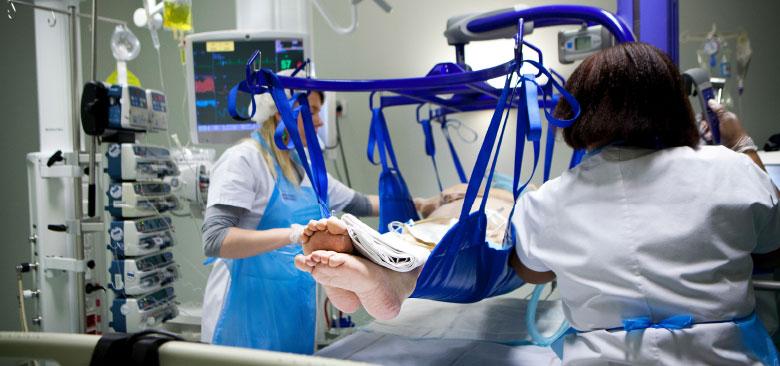
Do Safe Patient Handling Laws Protect Nurses from On-The-Job Injuries?
Hospitals are among the country’s most hazardous workplaces, with an estimated 224,700 work-related illnesses and injuries recorded in 2017, according to the United States Bureau of Labor Statistics. That incidence rate surpasses the construction industry. The physical demands on nurses certainly contribute to these numbers, says Soo-Jeong Lee, associate professor at the UC San Francisco School of Nursing.
“Nursing is a unique combination of high-tech and physically demanding tasks,” says Lee, who is now completing a series of studies that assess the impact of legislation in California aimed at reducing injury rates among hospital workers in the state.
A New Law Presents Important Research Opportunities
The Hospital Patient and Health Care Worker Injury Protection Act, which former California Gov. Jerry Brown signed in 2011, requires acute care hospitals to develop and implement safe patient handling policies, including training of workers and making mechanical lifting devices available for workers assisting patients. It also prohibits disciplinary action against workers who refuse to undertake patient lifting or repositioning tasks they consider unsafe.
Lee wanted to understand whether the legislation worked as intended, and sought nurses’ on-the-ground observations of the new law’s impact. She began a series of studies by convening several focus groups of nurses at acute care hospitals in the Bay Area, asking them about their experiences and perceptions of how the legislation was affecting their work. With funding from the National Institute for Occupational Safety and Health (NIOSH) and the School, Lee ultimately expanded that work by conducting a survey of 280 California nurses, which looked at how organizations were approaching safe patient handling in the wake of the legislation, and how those policies and processes were affecting injury rates among nurses.
Hospital Staffing Remains the Biggest Challenge to Worker Health
 Soo-Jeong Lee Both the focus groups and the survey reflected similar experiences and concerns. “We found the law had some positive impact, but there were still some challenges,” says Lee, who has spent her research career investigating worker health, with a focus on health care workers.
Soo-Jeong Lee Both the focus groups and the survey reflected similar experiences and concerns. “We found the law had some positive impact, but there were still some challenges,” says Lee, who has spent her research career investigating worker health, with a focus on health care workers.
According to the survey data, hospitals implemented policies, provided the required training and lift equipment and developed systems to report patient-handling-related injuries. The lift teams and making ceiling lift equipment available, in particular, were instrumental in a significant prevalence reduction in the rates of major musculoskeletal symptoms among nurses, from 61 percent to 52 percent, specifically in the low back, neck and hands and wrists. Moreover, though the numbers were not statistically significant, the prevalence rate of musculoskeletal injuries also tended to decrease after controlling for demographic and job characteristics.
Yet failing to provide adequate staffing remained an important barrier to making more significant progress in reducing injuries, says Lee.
The problem was that while the law improved hospital policies and programs for safe patient handling, hospital staffing levels remained largely the same. Even when using a lift, safely moving a patient often requires two or more workers, and pressures on nurses and nursing assistants to move patients promptly remained, despite the legislation. When a patient needs to be moved – either shifted in bed or assisted in walking to the bathroom, for example – their comfort and safety can be seriously affected by delays caused by waiting for a lift team or for a nurse to find a lift device.
“It isn’t easy to wait [for assistance],” Lee confirms. In fact, worried about their patients’ needs, nurses often try to do more than they are physically able to do.
Moreover, the time pressures on nurses and nursing assistants are only likely to increase. Lee says, “The work environment is changing. The population is aging, patients have more complex problems, and they’re getting heavier, while quality expectations are getting higher.” In particular, many patients are encouraged to move more during their hospitalizations, even shortly after major surgery, so nurses and nursing assistants are often called on to assist these patients.
In addition, while back and shoulder injuries associated with patient handling may be the most common injuries, they are not the only ones. In her research, Lee found that repetitive stress injuries are another common concern – one not addressed by the California safe patient handling legislation. “Nurses now constantly use computers and move carts, so there are a lot of other potential injuries,” she says.
Department of Labor Funds Latest Study in the Series
Lee published her findings from the California nurse surveys in a paper in Research in Nursing & Health and a subsequent paper earlier this year in American Journal of Industrial Medicine.
She has another study in progress with funding from the U.S. Department of Labor, which analyzes 10-year data from the California Division of Workers’ Compensation to compare injury data before and after the California legislation.
Teasing out what works — and what doesn’t — to protect health care workers from injury has important implications not just for nurses’ health, but also for patient outcomes.
“In health care, the focus has always been on the patient, but integrating and improving the worker safety is important,” Lee says. “Healthy workers can provide more quality care for patients.”



